|
Background - Why I Wanted to Take Part in the "March of the Living" Trip to Poland
|
|
|
|
|
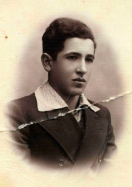 |
|
Mosze Szymon Rozenbaum in his
1938 Passport Photo |
|
|
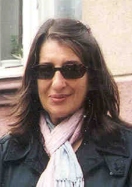 |
|
Helen Rosenbaum
in front of her father's Radzilow home, 2004 |
|
| |
|
|
|
 |
|
|
|
The March of the Living
was one of the most memorable and challenging journeys of my life.
This was a journey I
was always going to take with my father (Mosze Szymon Rozenbaum)
who very sadly died before this could happen. My paternal grandfather died in
January 1939 shortly before my father left for Australia. Dad always believed
that he could find the cemetery where his father was buried in Radzilow and
wanted me to accompany him. Shortly after his death, I began to think about
going to Poland.
There was always an
underlying sadness in my family as both my parents were the sole survivors of
their families. It seemed that Poland and the family who perished there were
always constant companions in our lives. In some small way I wanted to honor and
pay tribute to the lives of the family I was never privileged to know. As the
only granddaughter and niece, I felt I had to go to Poland to carry out my
father's lifelong wish whilst at the same time traveling the landscape of family
memory. The March of the Living made this journey possible, and for this I will
always be grateful.
Visit to Radzilow and Jedwabne
On one of the days set
aside for shtetl visits, I had organized a guide to take
me to Jedwabne and Radzilow. I wanted to visit Jedwabne as my father and his
brother sold grain and animal hides there at the weekly market. I also wanted to
go there as I had read "Neighbors" by Jan Gross in which he described the events
that took place in July 1941. On this fateful day half of the Polish town of
Jedwabne murdered the other half, 1600 men, women and children - all but 7 of
the town's Jews. The Poles herded the local Jews into a barn near the town's
Catholic and Jewish cemeteries and set it alight. They buried the charred bodies
in a ditch. In recent times I have learnt that many of the Jews of Radzilow
(including my family) suffered the same fate and were also burnt to death.
My guide Artur arrived
just after 6am on Friday to drive me to Jedwabne and Radzilow. He was a very
polite young man with a good command of English who worked at the Biebrzanski
National Park just east of Radzilow. Along the way we spoke about our lives and
the Holocaust. He said he was very sorry about what had happened in Poland and
felt that telling the truth was the only way forward. We drove through very
picturesque green countryside that was mostly devoid of animal life except for
the occasional cow. However we were lucky enough to see partridges, pheasants
and nesting storks. The further northeast we drove the poorer the towns became.
When we arrived in
Jedwabne, Artur decided that the best way to find out about local history was to
talk to some of the older residents of the town. We walked through the town
square and approached three old men sitting on a park bench. He introduced
himself and said he was interested in their lives and that I was a Jewish
visitor to Poland who had come to see her father's home in Radzilow. One of the
men started to cry and then grabbed my hand and kissed it and apologized for
what had happened in Jedwabne.
He then told us a story
about his mother who had tried to save two of her Jewish friends by pulling them
out of the square. She was unable to save them and they were pushed back into
the square, taken to the barn and burnt to death by the Poles. He then took us
to his home and showed us the photograph of his mother with her two Jewish
friends. He insisted that he should accompany us to the cemetery and to the
memorial erected to those Jews who perished in Jedwabne.
The memorial and
cemetery were located on the outskirts of the town in a fairly desolate area. He
then told us that the Polish Prime Minister had apologized to the Jews at this
memorial. The cemetery was very overgrown with weeds and bushes and all that
remains standing are one stonewall and a number of small simple headstones with
Hebrew letters covered with undergrowth. He then proceeded on his hands and
knees to uncover some of the graves and then asked if I could forgive him. I
just stood there in the middle of nowhere and froze. Suddenly I was faced with
the larger moral issue of forgiveness, I thought for a moment and realized I
could no longer be a silent bystander. I turned to him and said I could not
forgive him and nor was it my place to grant him forgiveness. We then left the
cemetery, drove him back to the square and headed for Radzilow. On the way we
picked up a hitchhiker who, when he learnt why I was in Poland, also kissed my
hand and apologized.
|
|
|
|
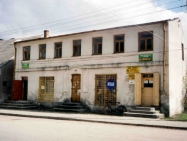
|
|
Police Station, where Mosze Szymon and family lived in
rented premises upstairs |
|
| |
|
Radzilow looks much
like Jedwabne, a small rural town with old stone and wooden houses and a village
green in the centre of town. Artur had contacted a local teacher before our
visit that put him in touch with Zofia, who knew the old Jewish sites of
Radzilow. She invited us into her home and gave us morning tea and then brought
an old man to talk to us. He was 92 years old and remembered many of the Jewish
families and where they lived. He did not know my father's family but remembered
the Fajkowski family and their home. Archie Fajkowski had been my father's best
friend. He said he was impressed that with all the pain and loss I had suffered
that I still wanted to visit Poland. He shook my hand at the end of the visit
and finished by saying he was not pleased with the Israeli/Palestinian
situation.
|
|
|
|
|
|
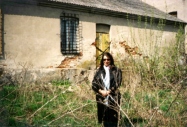 |
|
[L]: Late 1930's,
Mosze Szymon working
on a sewing machine
[R]: 2004, Helen Rosenbaum
standing in the same backyard |
|
|
|
|
|
Zofia came with us into
the square and pointed out the old Police Station where Dad and his family had
lived in rented premises upstairs. It
was an old faded yellow stone building now converted into two shops,
the upstairs was uninhabitable and could not be accessed. I then walked round to
the back of the building and stood in the place where many years earlier my
father had his photo taken sitting at a sewing machine. I stood and cried.
Everything I had ever heard about my family and the poverty they endured had
finally become a reality.
|
|
|
|
|
|
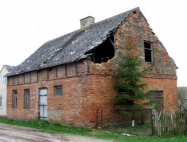 |
|
Wissa River
[Bottom]: Cheder |
|
| |
|
We continued on and
Zofia pointed out the Rabbi's house, a Jewish restaurant and the house where
Dad's friend Archie lived. We then walked to the site of the former synagogues
that were now stone barns to house animals. The Germans burned all three
synagogues and all that remains is a foundation stone under one of the barns. We
walked on to the watermill on the banks of the river where Dad and his friends
played. The river was much smaller than I imagined. It was also the place where
my father was so severely beaten by
some Poles that he and his friends never swam in the river again. We retraced
our steps and walked down a lane to the Cheder (religious school). The building
was intact but derelict. Walking down that lane I could almost hear the voices
of what was once a vibrant Jewish community.
|
|
|
|
|
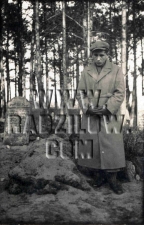
|
|
Late February 1939
Mosze Szymon, shortly before leaving Radzilow, paying his last
respects at the fresh grave of
his father, Zundel Rozenbaum, who
had passed away only four weeks earlier, on
Jan 22, 1939 |
|
|
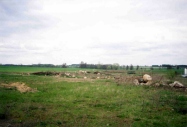

|
|
2004: The remains
of what once was the
Jewish cemetery, located
on the outskirts of town, opposite the school.
The site is now used
as a rubbish dump.
Note: The 1939 photo is
the only one uncovered thus
far of the original Cemetery. |
|
|
| |
|
|
We then drove to the
site of the former Jewish cemetery, of which nothing remains. It is now a vast
empty landscape covered with rocks and rubbish. I closed my eyes and visualized
the photo of my father standing at my grandfather's grave and then thanked God
that he was not here with me to see the devastation. Finally I had fulfilled
Dad's wish and had stood on the ground where my grandfather was buried. I said a
prayer and left a stone I had brought with me from Australia.
By this time I was so
emotionally and physically exhausted that all I wanted to do was to get back to
Warsaw. We bought Zofia a box of chocolates, thanked her and headed out of
Radzilow. This had been a truly momentous and heartbreaking day for me. It also
had a deep effect on Artur who now planned to interview older people and
document their oral histories. It was late evening when we arrived back at the
hotel. Artur had been a wonderful and sympathetic guide who had made a harrowing
day a little easier. He shook my hand, said "Shalom" and hoped that this would
be the start of better Polish/Jewish relations.
I walked into the hotel
totally drained by the events of the day. I changed and went down to have dinner
with the group and started to cry as I heard the Shabbat songs being sung. It
was wonderful to return to the support and comfort of the group and to be able
to share the traumas of a very sad day.
This will not be my
last visit to Poland. My next journey will be to pay tribute to my Mother's
family, all of whom perished in the Holocaust. |